#Obon Odori
Text
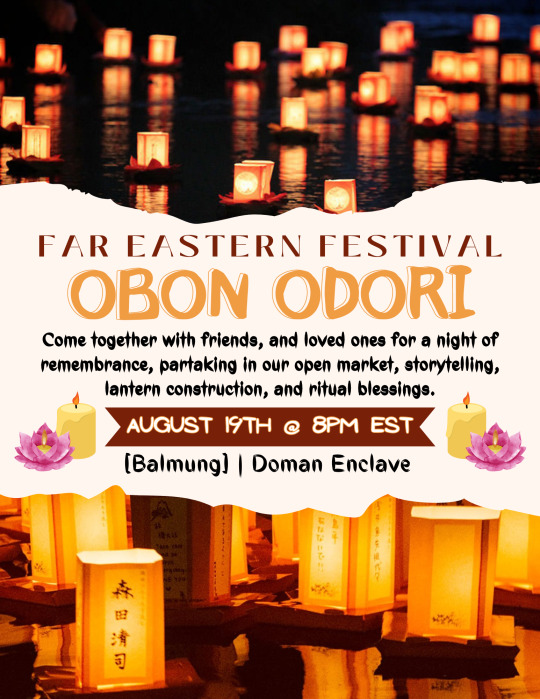
OBON ODORI
August 19th @ 8PM EST - 12AM EST
[Balmung] Doman Enclave
Together we remember and celebrate our ancestors and dearly departed on this, the night of the Obon Odori. Come together with friends, and loved ones for a night of remembrance, partaking in our open market, story telling, lantern construction, and ritual blessings before we send the lanterns down the river in a beautiful promenade as they lead our loved ones back to their resting place.
We start off with our opening ceremony after which you can enjoy local vendors and lantern construction. Once open market closes we will have honored guests sharing stories before the Bon dance begins. With lanterns in hand we head to the river to set them afloat and bid our ancestors goodbye until next time.
We are currently looking for storytellers, fortune tellers, vendors, including lantern construction.
Want to keep up with festival announcements? Join our discord: https://discord.gg/z9T954mqRp
Carrd: TBA
#far eastern festival#crystal data center#balmung#Obon Odori#Doman Enclave#Roleplay Event#FFXIV RP#ffxiv
80 notes
·
View notes
Text
Kasha and Toyo went to the Obon Odori festival

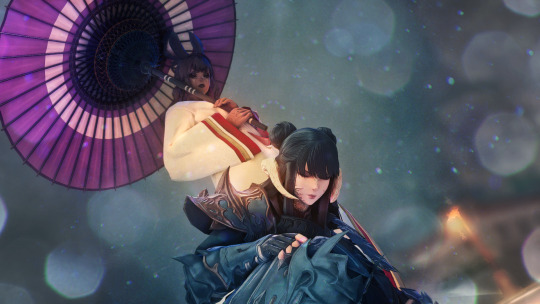
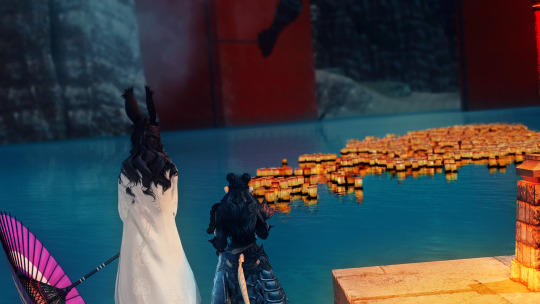
(I haven't done big photo editing like this in a long time but I think I did okay, just wish i was good enough to fix the water)
#ffxiv oc#ffxiv gpose#ffxiv screenshots#ffxiv rp#ff14 gpose#ff14 screenshot#ffxiv#obon odori#far eastern festival
15 notes
·
View notes
Text
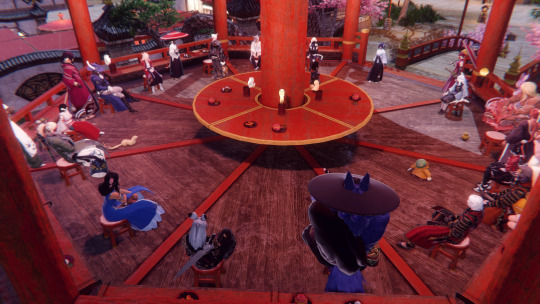
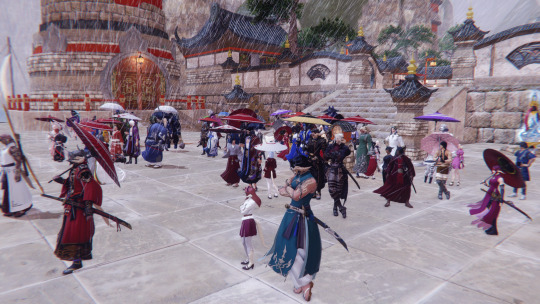


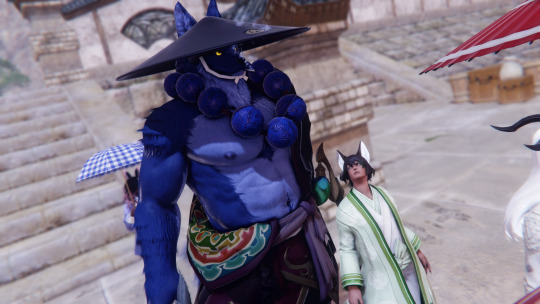
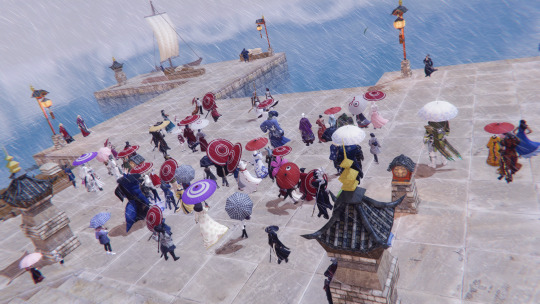
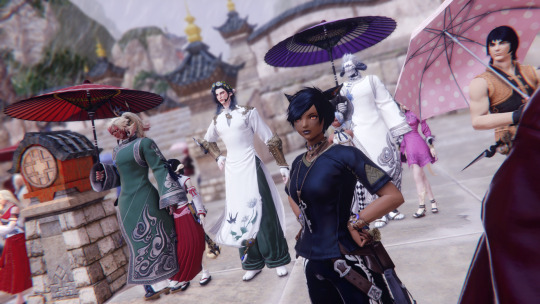
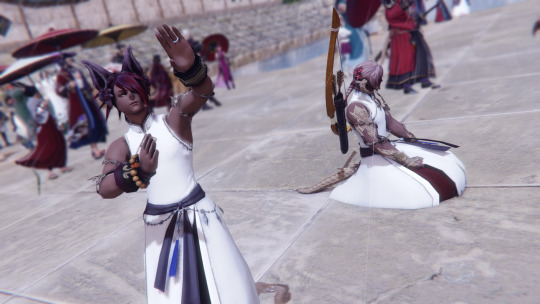
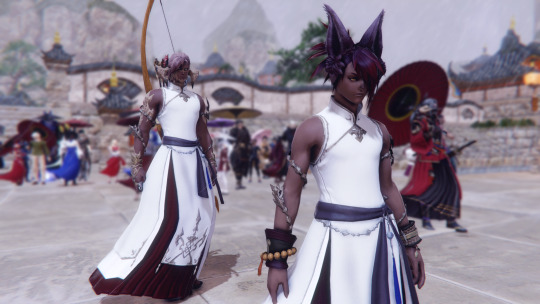

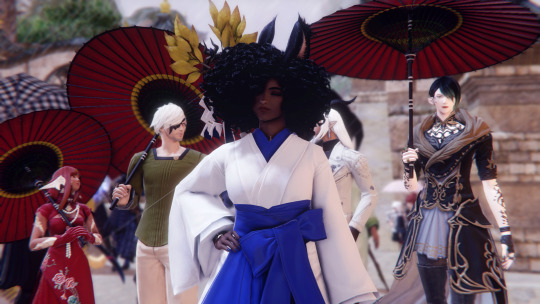
Obon Odori 2023 🏮🕯️
29 notes
·
View notes
Text


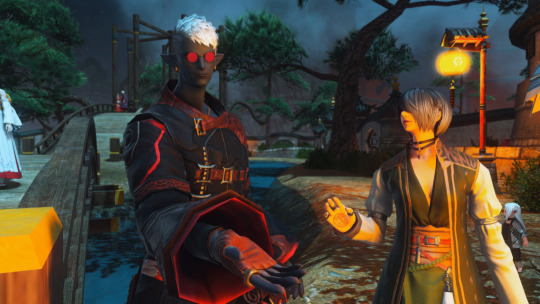

OBON ODORI FESTIVAL was on today! I attended with my lovely wife @archaiclumina and her amazing blorbo Oli.
Overall it was great. We met and got to RP with a new person (She was lovely now we protecc (ง ͠ಥ_ಥ)ง). The vendors were fantastic and the hosts did such great work on the event. I only wish I'd started the Doman Enclave before as a few NPC's were in questionable places lol.
17 notes
·
View notes
Text
5 Summer Festivals in Japan
1) Nebuta Matsuri ねぶた祭 (Aomori)

Pic by annintofu
Held in Aomori Prefecture from August 2 to 7. The festival is known for its enormous lantern floats of up to nine meters high, made of painted washi paper over wire frames which takes a year to design and construct. They depict gods, historical samurai and mythical figures like the legendary beasts, Nebuta.
Source : Japan Guide
2) Tokushima Awa Odori 阿波おどり (Shikoku)

Pic by Justin Bowdidge
Held in Tokushima Prefecture during the Obon season from August 12 to 15. In the evening, the city center shuts down as the streets turn into a large dance stage where the performers dance down the streets for onlookers to see and join in the fun, there are also game and food stalls decorating the streets.
Source : Japan Guide
3) Gion Matsuri 祇園祭 (Kyoto)

Pic by TokyoViews
Also known as the festival of Yasaka Shrine which takes place throughout the whole month of July, where there are grand procession of floats, Yamaboko Junko during the day and Yoiyama in the evening. It dates back to 869 as a religious ceremony to appease the gods during the outbreak of an epidemic.
Source : Japan Guide
4) Hanabi 花火 (the most famous one in Kamakura)
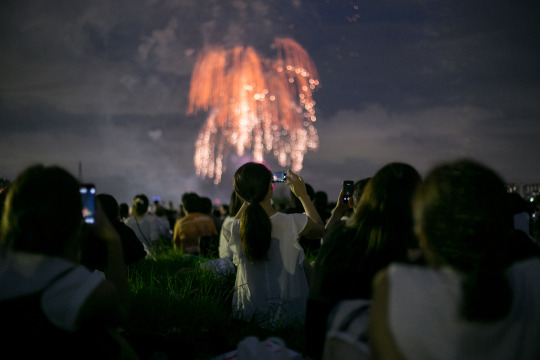
Pic by Bensen Ho
Hanabi means fireworkds, the festival originally meant to ward off evil sprits in ancient times is now held during the summer holidays in July and August. A festival that is widely portrayed in anime and dramas where people dressed in yukata come together to enjoy good food, fun games and beautiful fireworks.
Source : Japan Guide
5) Kishiwada Danjiri Matsuri 岸和田だんじり祭 (Osaka)

Pic by Guifré
Held in September in the city of Kishiwada in southern Osaka Prefecture. A 300-year-old tradition, Danjiri Matsuri (wooden float festival) brings a team from each of Kishiwada’s thirty-four neighborhoods together to compete by manually pulling their four-ton danjiri through the city’s streets.
Source : Osaka Info
#japanese festival#japanese matsuri#summer festival#summer matsuri#nebuta matsuri#aomori prefecture#aomori#tokushima#awa odori#obon dance#shikoku#gion matsuri#kyoto#gion#hanabi#kamakura#kishiwada danjiri matsuri#kishiwada#danjiri matsuri#osaka prefecture#japan#japanese culture#japanese tradition#japanese history
30 notes
·
View notes
Text
👀 Some Japanese fans are speculating that Outogawa (王途川) might be the final of the Great Noble Clans because if you remove the | from 王 your get 三途(の)川 aka the Sanzu River which separates this world from the next
#the family that wants to keep Jigoku separated from the other worlds HMM...#bleach#outogawa furuoki#he's the sexiest of the ogs so he deserves a little notoriety. as a treat.#oh now that i think about it he's wearing a hat they use for Awa Odori which is a dance for the Obon Festival... aka honoring the dead.. hmm#sanpost kenjuu
9 notes
·
View notes
Photo

Awa Odori 2022 was once again a success!
📍: Awa Odori (Awa Dance Festival), Tokushima Prefecture, Shikoku, Japan
📸: @zomekix (top) & @jusui_awa (bottom) - {IG}
#japan photos#japan festival#awa odori#awa odori 2022#阿波踊り#dance festival#tokushima#tokushima prefecture#徳島県#shikoku#四国#obon festival#お盆#awa dance#i love japan#amazing japan#japan photography#japan daily#japan#日本#japan tourism#japan culture#japan tradition#japan pictures#japan photo#discover japan#travel photography#japan travel#akaiji
2 notes
·
View notes
Text
A fun thing about Southern California is that Obon has Elvises.
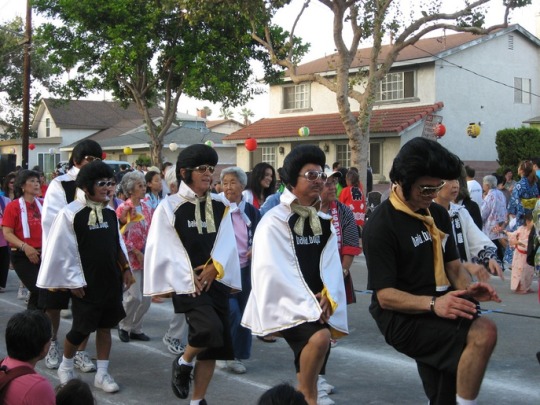
#this picture is ancient but they're still doing it#this was just the best picture that pulled up#and it's creative commons#obon#bon odori#elvis#japanese american#the group grows and shrinks#there were SO MANY PEOPLE at gardena's obon this year#they ran out of food 😭
0 notes
Text
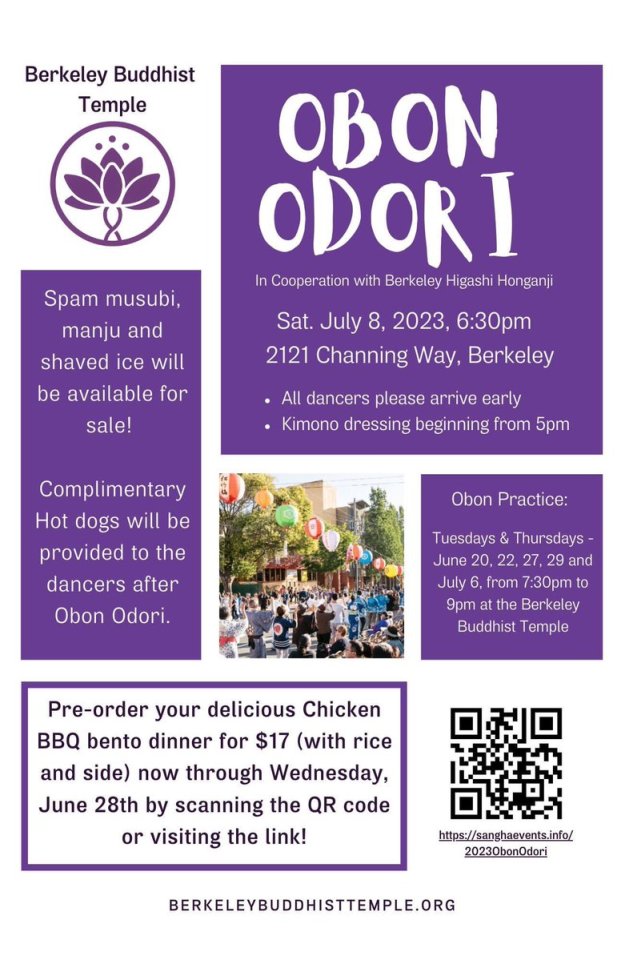
👘 Please join our Bay District Friends at the Berkeley Buddhist Temple in cooperation with the Berkeley Higashi Honganji for their Obon Odori on Saturday, July 8, at 6:30pm. 🎶
#berkeley#Berkeley Buddhist temple#bbt#obon#bon dance#bon odori#buddhism#obon season#bon dance season#funraiser#nonprofit#support non profit#bay area#california
0 notes
Text

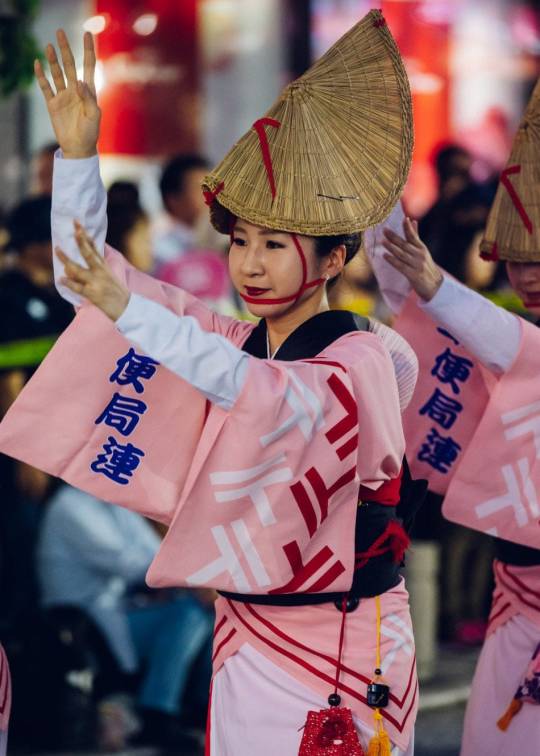


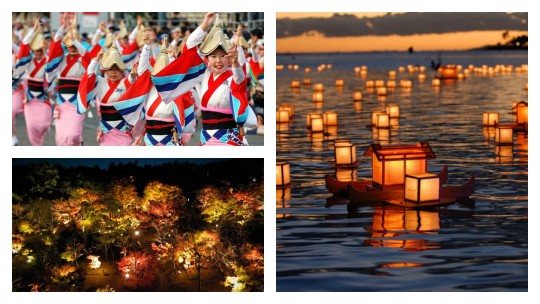

Sean bienvenidos, japonistasarqueológicos a una nueva entrega, en esta ocasión hablaré sobre Obon el festival de los difuntos una vez dicho esto pónganse cómodos que empezamos.
-
En Japón, en los días de agosto, del 13 al 16, se celebra el Obon, que lo podemos ver en multitud de animes, películas y doramas ya hice mención sobre que estas cosas no solo hay que verlas, como meros dibujos, ya que tienen mucho sentido cultural e histórico. Esta festividad tiene muchos elementos muy característicos como el Gozan no Okuribi también llamado Daimonji, muy característico de finales de estas fiestas, porque suelen ser una serie de dibujos alguno de un torii y otros como el kanji de fuego, por mencionar algunos ejemplos.
-
Los pepinos(se utiliza para cuando el difunto llega) y berenjenas(caso contrario cuando el difunto se va ) simbolizan la llegada y el regreso del difunto al más allá. Hay muchos países que celebran esta festividad de formas distintas, pero todos tienen en común que honran a sus antepasados, es una festividad que tiene 400 a 500 años de antigüedad y es de origen budista. Para finalizar la publicación mencionaremos el Awa-Odori, (Odori significa bailar) y data del siglo XVI.
-
Espero que os guste y nos vemos en próximas publicaciones, que pasen una buena semana.
日本の考古学者の皆さん、新しい回へようこそ。今回はお盆についてお話ししましょう。
-
日本では、8月の13日から16日にかけて、お盆の行事が行われる。 アニメや映画、ドラマなどでもよく見かけるが、これらは単なる絵空事ではなく、多くの文化的、歴史的な意味を持っていることはすでに述べた。例えば、五山の送り火は「大文字」とも呼ばれ、鳥居の絵や「火」という漢字の絵など、お盆の風物詩となっている。
-
キュウリ(故人が来るときに使う)とナス(故人が帰るときに使う)は、故人があの世に到着し、戻ってくることを象徴している。この祭りをさまざまな方法で祝う国はたくさんあるが、先祖を敬うという点では共通している。阿波踊りは16世紀に遡る。
-
それでは、良い一週間を。
Welcome, Japanese archaeologists to a new installment, this time I will talk about Obon, the festival of the dead, and with that said, make yourselves comfortable and let's get started.
-
In Japan, in the days of August, from the 13th to the 16th, Obon is celebrated, which we can see in many anime, movies and doramas. I have already mentioned that these things should not only be seen as mere drawings, as they have a lot of cultural and historical meaning. This festivity has many very characteristic elements such as the Gozan no Okuribi also called Daimonji, very characteristic of the end of these festivities, because they are usually a series of drawings of a torii and others such as the kanji of fire, to mention some examples.
-
Cucumbers (used for when the deceased arrives) and aubergines (otherwise when the deceased leaves) symbolise the arrival and return of the deceased to the afterlife. There are many countries that celebrate this festival in different ways, but they all have in common that they honour their ancestors, it is a festival that is 400 to 500 years old and is of Buddhist origin. To end the publication we will mention the Awa-Odori, (Odori means dancing) and dates back to the 16th century.
-
I hope you like it and see you in future publications, have a nice week.
#日本#歴史#文化#オタク#アニメ#お盆#阿波踊り#五山の送り火#大文字#ユネスコ#祖先#Japan#history#culture#otaku#anime#Obon#AwaOdori#GozannoOkuribi#Daimonji#unesco#ancestors
35 notes
·
View notes
Text
Household Festivals in Shinto
Shinto festivals are usually celebrated at shrines. For those who do not live near a shrine, here is my adapted festival calendar. The dates for these festivals may vary due to astronomical or calendrical reasons.
New Year's Day (Oshogatsu):
On New Year's Day, eat and make lucky foods known as Osechi. Some recipes are listed here. Many Japanese people go to a shrine or temple for the first time in the new year, a practice called hatsumode. Instead of this, worshipers abroad could try offering sake at the kamidana.
Setsubun
Setsubun marks the beginning of spring. This is celebrated on either February 3 or 4. The date for Setsubun moves one day every 20 years. On this day, children throw roasted soybeans out the door or at an adult wearing an oni mask and chant "(鬼は外! 福は内!" (Oni go outside, luck come inside!). You can also eat roasted soybeans equivalent in number to your age.
Hinamatsuri
Hinamatsuri is held on March 3 at home by families who often are gifted hina dolls. These are carefully laid out, with votive miniature mochi in front of them. Special lanterns are laid out on both sides. Sometimes there are many dolls to play music and entertain the main couple. The purpose of this holiday is to pray for a good marriage for your daughter. Of course, this is quite heteronormative, but I wanted to include this just in case.
Haru Higan
Haru Higan is usually celebrated around March 20 for seven days. On this day, those with Japanese ancestry can worship their ancestors. Everyone can appreciate the coming warmth of spring as well.
Tanabata
Tanabata is usually celebrated on July 7, though some celebrate it on August 7. This commemorates the day that two literally star-crossed lovers, an oxherd and a weaver, can meet by crossing the Milky Way. If it rains, it is said that the weather prevents them from meeting until the next year. If it is clear, they are able to be reunited. You can write wishes on pieces of paper and hang them on bamboo stalks.
Obon
Obon is a major summer holiday held in honor of ancestors on July 15 or August 15 depending on the family. This one is often more Buddhist-flavored. You can make a small fire (real or symbolic -- and please be mindful of fire safety) as a landmark for your ancestors to find your home. Traditionally, specific altars just for the ancestors who return during Obon are constructed. A common practice is to construct horses and cows out of cucumbers and eggplants, respectively. The method for this is simple -- simply stick toothpicks in for their legs! It is said that this is to make ancestors come faster and leave slower. Bon Odori (Bon Dances) are held where slow traditional songs are played, and locals dance in a circle around a high platform with a drummer on it. This is a time of much fun and games. Fires are also lit at the ancestors' departure.
Tsukimi
Tsukimi is the moon-watching festival held on the eighth month of the lunar calendar on the 15th day. Traditions for this festival include making tsukimi dango (recipe here) and offering them on a sanbo tray by a window. You can also offer seasonal fruits and vegetables, and sprigs of susuki, or pampas grass.
Aki Higan
Aki Higan is the fall festival on September 22 or 23 marking the beginning of fall and cooler seasons in Japan. This is another day for worshiping one's ancestors.
Preparing for the New Year
At the end of the year, get mochi, shimekazari and any other items you need in preparation for the New Year. You may also wish to clean your home at this time.
*I may update this list later!
24 notes
·
View notes
Text
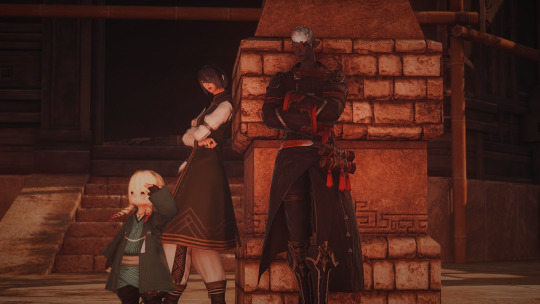
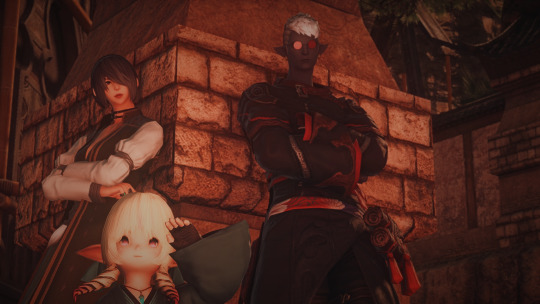
Found ourselves a Lalafell to protect at the Obon Odori.
if you're mean to her, we'll beat you up! (ง'̀-'́)ง
19 notes
·
View notes
Text
I had a lot of fun as Kasha at the obon odori, met a couple new people, Gidson, Sakura, Nene, and Akira, good rp yeyeyeye
My wifi cut out like 4 times and I had to change locations in the middle of the event but it's alright
I'll maybe take pictures once I get home
5 notes
·
View notes
Text
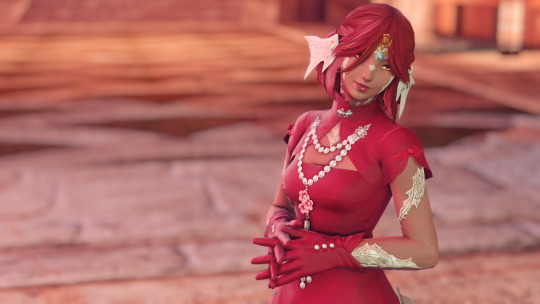
Azuma is going to be at the Obon Odori! Unfortunately, the Doman Enclave is not nearly built up enough on her to have nice screenshots, but she will be a vendor for The Fireside if you'd like a coffee!
#。・゚゚・ — 𝐜𝐡𝐚𝐫𝐚𝐜𝐭𝐞𝐫 : azuma#poor siyoh has covid#and i'm like 99% sure is going to sleep through it#so come keep me company!#and get a coffee#>:)
13 notes
·
View notes
Note
Thank you for responding civilly to me :).
I appreciate that you didn't teach it as the "Mexican Halloween" like most teachers do when they speak about el Dia de los Muertos, it can get really frustrating when all throughout my years in middle and highschool and those of my other friends who've gone to school in different areas taught it as a Hispanic version of Halloween.
I find it interesting how Japanese people also have their own festival to honor the dead and welcome their visiting spirits, and the difference in how they celebrate and decorate. I'll definitely research their Obon festival :D
No problem! That sentiment in the US is unfortunately common, even in areas where there are a lot of Mexican-Americans that you can like. Talk to. And learn easily that it's a different thing from Halloween.
Obon is really cool! It's a festival honoring the dead but like Dia de los Muertos, it's not somber or sad and is super fun. They do fireworks, festival stalls, and they have traditional dances they do called Bon Odori. They don't paint their faces tho and don't have a symbol/icon like La Catrina, so my kids were VERY surprised to see pictures of so many people dressed up in Mexico with face paint and colorful costumes. They DO like to wear yukata though since Obon takes place in summer and it can get kind of hot.
And bless their hearts, some of my kids really tried hard to say all the Spanish words like "Dia de los Muertos", "La Catrina", "ofrenda", etc. The one they all said easily was "pan" when I was showing them "pan de muerto" since the Japanese word for bread IS "pan". But they were really struggling with the rest lol. Some would try to say "dia de los Muertos" and others just gave up and call it "メキシコのお盆" (Obon of Mexico) instead. But they all thought it was super cool!
11 notes
·
View notes
Text
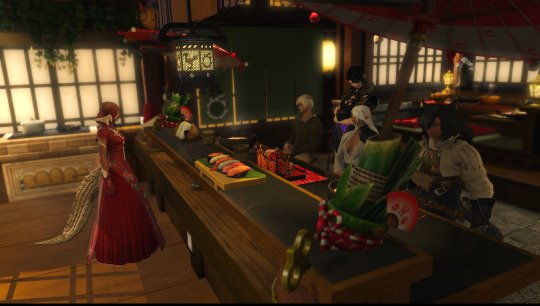
Sometime after the Obon Odori with some friends.
10 notes
·
View notes